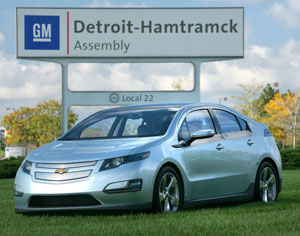
DETROIT – Lawmakers on both sides of the aisle say the ouster of General Motors Co. CEO Fritz Henderson was a decision that was rightly made by the auto maker’s board of directors, and not the government.
But speaking during an event here to announce GM’s $336 million investment in Chevrolet Volt assembly at the auto maker’s Detroit-Hamtramck plant, Michigan Congressmen Thaddeus McCotter (R-MI) and Sander Levin (D-MI) tell Ward’s last week’s decision to remove Henderson should not be a mystery.
“Henderson’s departure raised more questions, especially for the working families, than it answered,” McCotter says on the sidelines here.
“People that work at GM should have been told, and I think they need to know the reasons. Because your whole livelihood depends on working at GM on the line or in the boardroom, you want to know what’s going on, and this created more anxiety in an already uncertain time.”
But while taxpayer support requires GM to be accountable, the government should keep its distance from the auto maker’s day-to-day operations, Levin says.
Ron Bloom, head of the government’s autos task force, “wasn’t going to get into this,” Levin adds, noting “it’s not up to members of Congress or the White House to tell (GM) what to do. Once we start down the road of involving ourselves in these decisions, there’s no end to it. It’s up to them, and we made it very clear.”
GM Chairman Ed Whitacre, who temporarily has assumed the CEO post while a search for Henderson’s replacement gets under way, reportedly says he would like someone from outside the auto industry to assume the position.

However, pundits suggest federal pay restrictions likely will discourage talents such as Ford Motor Co. CEO Alan Mulally, who was lured from aerospace giant Boeing Co. with a multi-million-dollar compensation package.
Levin is more confident. “There are other ways to compensate executives, including issuing stock options,” he says. “Essentially, we more and more want people to be paid for performance.
“I think GM ought to be able to attract someone and pay them within the cap and say, ‘Help with the transformation of this company, and you’ll be adequately compensated if you succeed. If you fail, you won’t receive as much as you would have.’”
Meanwhile, GM’s investment announcement today brings combined Volt-related expenditures in Michigan to $700 million, covering eight state facilities.
The Detroit-Hamtramck facility will be the final assembly location for the Volt extended-range electric vehicle. The site will utilize tooling from Grand Blanc,; lithium-ion batteries from GM’s Brownstown Township, battery-pack manufacturing plant; camshafts and connecting rods from Bay City, and stampings and the Volt’s 1.4L engine-generator from Flint.
The $336 million investment announced today will pay for upgrades at the Detroit-Hamtramck plant, says Jon Lauckner, GM vice president-global planning.
“We’re in the phase of installing the machinery and equipment in the body shop, in the paint shop and in general assembly,” he tells Ward’s. “It’s a brand-new vehicle based on our global compact-car architecture, so there’s a fare amount of work that needs to be done.”
Lauckner says Volt development is on schedule and product and process validation vehicles are scheduled to roll off the line in the spring.
GM says it hopes to sell some 8,000 Volts in 2011, and eventually ramp up volume to 60,000 units annually.



